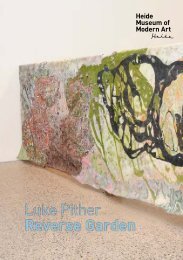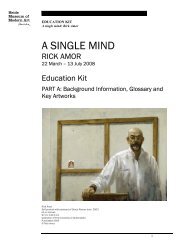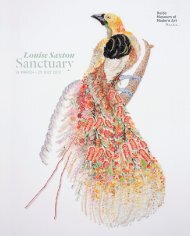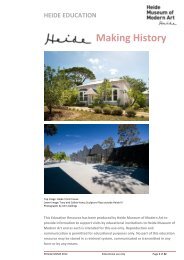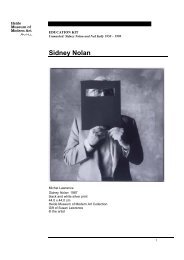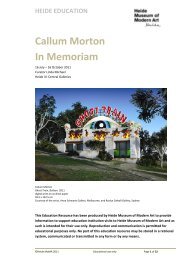Heide Museum of Modern Art 2010 Annual Report
Heide Museum of Modern Art 2010 Annual Report
Heide Museum of Modern Art 2010 Annual Report
You also want an ePaper? Increase the reach of your titles
YUMPU automatically turns print PDFs into web optimized ePapers that Google loves.
14. Notes to the Financial Statements<br />
Improvements<br />
The company acts as a government<br />
appointed committee <strong>of</strong> management with<br />
respect to the property known as <strong>Heide</strong><br />
Park and <strong>Art</strong> Gallery. The directors are <strong>of</strong><br />
the opinion that the custodianship over<br />
<strong>Heide</strong> Park is permanent in nature and<br />
therefore they believe that it is appropriate<br />
to value the leasehold improvements on a<br />
basis consistent with AASB 116 Property,<br />
Plant and Equipment. The value <strong>of</strong><br />
capitalised leasehold improvements will be<br />
amortised over their expected useful life<br />
(applicable amortisation rate used is 2.5%).<br />
Leasehold improvements are amortised<br />
over 40 years.<br />
In the current period, an independent<br />
market valuation was conducted by<br />
Wilson Pride Valuations. The leasehold<br />
improvements were valued at $11,280,180<br />
on 4 February 2011.<br />
Plant and equipment<br />
Plant and equipment are measured on<br />
the cost basis less depreciation and<br />
impairment losses.<br />
The carrying amount <strong>of</strong> plant and<br />
equipment is reviewed annually by<br />
directors to ensure it is not in excess <strong>of</strong><br />
the recoverable amount from these assets.<br />
The recoverable amount is assessed on<br />
the basis <strong>of</strong> the expected net cash flows<br />
that will be received from the assets<br />
employment and subsequent disposal.<br />
The expected net cash flows have been<br />
discounted to their present values in<br />
determining recoverable amounts.<br />
Note 1: Accounting policies<br />
Increases in the carrying amount arising<br />
on revaluation <strong>of</strong> land and buildings are<br />
credited to a revaluation reserve in equity.<br />
Decreases that <strong>of</strong>fset previous increases<br />
<strong>of</strong> the same asset are charged against<br />
fair value reserves directly in equity; all<br />
other decreases are charged to the income<br />
statement.<br />
Depreciation<br />
The depreciable amount <strong>of</strong> all fixed<br />
assets including buildings and capitalised<br />
leased assets, but excluding freehold<br />
land, is depreciated on a straight-line<br />
basis over their useful lives to the<br />
Company commencing from the time<br />
the asset is held ready for use. Leasehold<br />
improvements are depreciated over the<br />
shorter <strong>of</strong> either the unexpired period <strong>of</strong><br />
the lease or the estimated useful lives <strong>of</strong><br />
the improvements.<br />
The depreciation rates used for each class<br />
<strong>of</strong> depreciable assets are:<br />
Buildings 2.5%<br />
Plant and Equipment 20%<br />
Computer Equipment 40%<br />
Leasehold improvements 2.5%<br />
Impairment<br />
The assets’ residual values and useful lives<br />
are reviewed, and adjusted if appropriate,<br />
at each balance sheet date.<br />
An asset’s carrying amount is written down<br />
immediately to its recoverable amount if<br />
the asset’s carrying amount is greater than<br />
its estimated recoverable amount.<br />
<strong>Heide</strong> <strong>Museum</strong> <strong>of</strong> <strong>Modern</strong> <strong>Art</strong><br />
<strong>2010</strong> <strong>Annual</strong> <strong>Report</strong><br />
Gains and losses on disposals are<br />
determined by comparing proceeds with the<br />
carrying amount. These gains or losses are<br />
included in the income statement. When<br />
revalued assets are sold, amounts included<br />
in the revaluation reserve relating to that<br />
asset are transferred to retained earnings.<br />
f Leases<br />
Leases <strong>of</strong> fixed assets where substantially<br />
all the risks and benefits incidental to the<br />
ownership <strong>of</strong> the asset, but not the legal<br />
ownership are transferred to the company<br />
are classified as finance leases.<br />
Finance leases are capitalised by recording<br />
an asset and a liability at the lower <strong>of</strong> the<br />
amounts equal to the present value <strong>of</strong><br />
the minimum lease payments, including<br />
any guaranteed residual values. Lease<br />
payments are allocated between the<br />
reduction <strong>of</strong> the lease liability and the<br />
lease interest expense for the period.<br />
Leased assets are depreciated on a<br />
straight-line basis over their estimated<br />
useful lives where it is likely that the<br />
company will obtain ownership <strong>of</strong> the<br />
asset or over the term <strong>of</strong> the lease<br />
Lease payments for operating leases, where<br />
substantially all the risks and benefits<br />
remain with the lessor, are charged as<br />
expenses in the periods in which they are<br />
incurred.<br />
58



